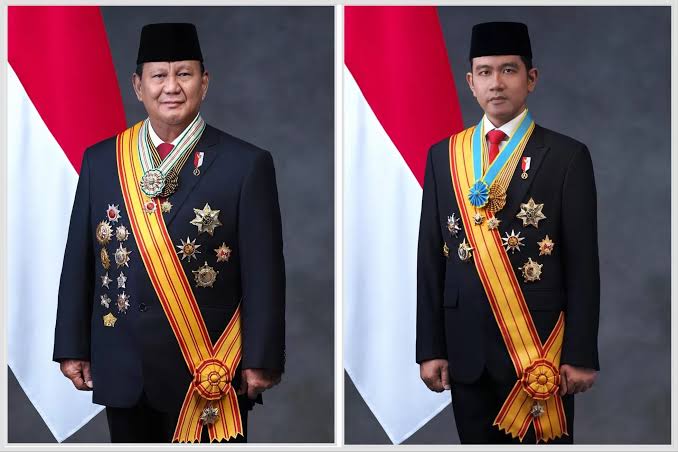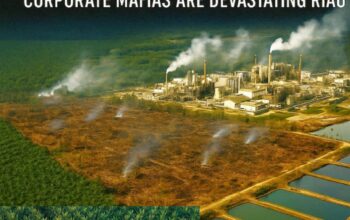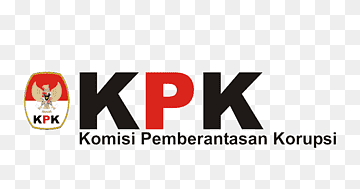Riau, once hailed as the green heart of Sumatra, has transformed into a sprawling industrial landscape dominated by palm oil plantations, industrial timber estates (HTI), and massive shrimp farms lining its coastline. Over 3.5 million hectares of natural forest have vanished, replaced by monocultures of acacia, eucalyptus, and oil palm owned by corporate giants such as APRIL Group, Sinar Mas Forestry, Wilmar, Asian Agri, and subsidiaries of state-owned PTPN. Though Riau still appears green on satellite images, it’s no longer the green of protected forests or mangroves—it’s the green of the world’s largest palm oil belt, now flanked by shrimp ponds from Bengkalis in the north to the shores of Indragiri Hilir. (08/07)
Amid this ecological collapse, the Riau Provincial Government, together with corporations and environmental NGOs, promotes a paradoxical recovery narrative through RSPO/ISPO sustainability certification schemes and carbon trading initiatives. Marketed as solutions to climate change and deforestation, these schemes are, in reality, some of the most glaring examples of systemic greenwashing in Indonesia.
The Tesso Nilo National Park Foundation (YTTN), established in 2005 to conserve Sumatra’s lowland rainforest and wildlife, has shifted its role—becoming a green legitimizer for major corporations. In many RSPO certification documents, YTTN appears as a socio-environmental partner: giving recommendations, preparing technical reports, and mediating community disputes. However, YTTN is not an independent auditing body. Its role is to repackage conservation narratives to satisfy audit firms like TUV Rheinland, SGS, or SCS Global Services—many of which accept reports without rigorous field verification.
At the government level, the Riau Plantation Agency (Disbun) plays an active role in accelerating this green legitimacy. Instead of monitoring environmental and forestry compliance, Disbun facilitates the RSPO/ISPO certification process—especially for corporate-backed farmer cooperatives. In districts like Pelalawan, Indragiri Hulu, and Rokan Hilir, farmers admit they received significant assistance from Disbun to legalize their land, even though much of it lies within protected forest zones with no formal legal release.
PTPN IV and V, both state-owned enterprises, follow similar patterns. While branding themselves as pioneers of sustainable palm oil, many of their concessions still lie within production forests and peatlands lacking legal clarity (“unclear and unclean” status). Partnering with YTTN and environmental consultants, they produce flora-fauna inventories, social mitigation plans, and High Conservation Value (HCV) maps. These documents are rarely subjected to independent impact verification.
APRIL Group, through its subsidiary PT RAPP, is the most striking example. Managing hundreds of thousands of hectares of timber plantations for its pulp mill in Pangkalan Kerinci, APRIL aggressively promotes its green image via restoration programs and carbon offset projects. Its flagship carbon project, the Riau Ecosystem Restoration (RER) in the Kampar Peninsula, is said to have attracted over USD 100 million in funding over a decade—from foreign donors, REDD+ schemes, and carbon offset partners. Yet, HTI expansion continues in peatlands and former conservation zones, directly undermining restoration claims.
Sinar Mas Forestry, through PT Arara Abadi and PT Indah Kiat Pulp & Paper (IKPP), employs similar strategies. They partner with local foundations, universities, and donor agencies to bolster their green credentials. Areas like the Giam Siak Kecil–Bukit Batu Biosphere Reserve (705,000 hectares), once established to protect wildlife, are now surrounded by HTI expansion and plagued by agrarian conflict in Siak, Bengkalis, and Dumai. Local NGOs are often listed in environmental impact assessments (AMDAL) and sustainability reports, but rarely contribute meaningfully on the ground.
The irony deepens with the flow of donor funds. Local NGOs including YTTN receive grants from global institutions such as UNDP, NORAD, USAID, and GIZ, as well as from the CSR arms of APRIL, Sinar Mas, Wilmar, and Asian Agri. These funds are packaged as conservation, empowerment, or research initiatives. Yet, no audited financial reports are publicly available. Community-based carbon trading schemes often serve as veils for compensation systems that benefit foundation elites, environmental consultants, and local bureaucrats.
Meanwhile, ground data shows environmental destruction is accelerating. Tesso Nilo National Park, once a key habitat for endangered elephants and tigers, has lost over 28,600 hectares to degradation. Around 36,353 hectares have been illegally planted with oil palm, much of it linked to Wilmar and Asian Agri’s supply chains. Rokan Hilir has lost more than 464,000 hectares of forest between 1990 and 2013, followed by Pelalawan, Indragiri Hulu, Kampar, and Bengkalis—all among the worst deforestation zones. Across Riau, over 70% of peatland has been converted to plantations, with only 940,000 hectares remaining—now under severe threat.
Even more alarming, Riau’s coastal areas are now being carved by illegal shrimp farms, destroying mangroves and marginalizing traditional fishers. From Rupat Utara and Bantan to Sungai Pakning, Pulau Burung, and Teluk Belitung, thousands of hectares of coastline have been cleared, mangroves uprooted, and shallow water ecosystems ruined. These operations are shielded from law enforcement, allegedly due to collusion between local officials and foreign capital investors.
All these schemes serve one ultimate purpose: to sell the illusion that Riau’s palm oil and pulp and paper industries have gone green and sustainable. The reality is the opposite. Forest fires still rage every dry season. Elephant and tiger populations are dwindling. Major rivers are polluted. Agrarian conflicts are rising. And Indigenous communities like the Sakai, Talang Mamak, and Old Malay continue to lose their ancestral lands.
What’s happening in Riau is not just a failure of governance—it is a triumph of manipulation, orchestrated by environmental foundations, regional bureaucracies, state-owned firms, global corporations, and international certification bodies. Riau today is not a model of successful restoration, but a grand stage of green illusion—deceiving the world while bleeding the land dry.







